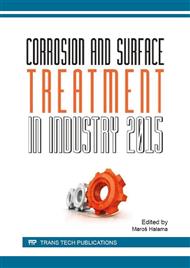[1]
CALLCUT, V. The brasses: properties & aplications. 2. ed. Hemel Hepstead : CDA Publication, no. 117, 2005, 37.
Google Scholar
[2]
POLMEAR I. J., Light Alloys Light Alloys, Fourth edition, 2006, 421.
Google Scholar
[3]
ČERNÝ, M. et al. Korozní vlastnosti kovových konstrukčních materiálů. 1. vyd. Praha, SNTL - Nakladatelství technické literatury, (1984).
Google Scholar
[4]
AVEDESIAN, M. M. - BAKER, H. Magnesium and Magnesium Alloys. In Materials Park OH: ASM International, 1999, 314.
Google Scholar
[5]
BABOIAN, R. 2005. Corrosion tests and standards: Aplication and interpretation. 2. ed. ASTM International, (2005).
Google Scholar
[6]
ABOUSWA, K. – ELSHAWESH, F. - ELRAGEI, O. - ELHOOD, A., Corrosion investigation of Cu–Ni tube desalination plant, Desalination 205, 2007, 140.
DOI: 10.1016/j.desal.2006.05.013
Google Scholar
[7]
BLANTER, M. Internal Friction in Metallic Materials. Springer - Verlag: Berlin Heidelberg, 2007, 539.
Google Scholar
[8]
ZHANG, Z., ZENG, X., DING, W. The influence of heat treatment on damping response of AZ91D magnesium alloy. In: Materials Science and Engineering, vol. 392, issues 1-2, 2005, 150.
DOI: 10.1016/j.msea.2004.09.056
Google Scholar
[9]
OISHI, K. - TSUJI, T. – WATANABE, Y., Proc. Int. Sym. Corrosion of coper and coper alloys in building, Ja. CDA, Tokyo (1982).
Google Scholar
[10]
KONDRASHIN, V. U. et al. Prot. Metal (USSR), 25, (5), 1989, 745.
Google Scholar
[11]
NAMBOODHIRI, T. K. G. et al: Corros. Science, 22, (11), 1982, 1037.
Google Scholar
[12]
LOMBARDI, P.: Met. Ital. 45, 449, Ibid 1954, 46 (3) 91, Ibid. 46 (4), 123.
Google Scholar
[13]
CHEN, J.L. – LI, Z. – ZHAO, Y.Y. Corrosion characteristic of Ce Al brass in comparison with As Al brass, Materials and Design 30, 2009, 1743.
DOI: 10.1016/j.matdes.2008.07.041
Google Scholar
[14]
POMENIC, L. – Electrochemical behaviour of Al-Brass in seawater. In 10th International Research/Expert Conference: Trends in the development of machinery and associated technology, (2006).
Google Scholar
[15]
LIPTÁKOVÁ, T. - ZATKALÍKOVÁ, V. Transaction of Famena, 33, 1, 2009, p.31.
Google Scholar
[16]
SOUKUP, J. Hydromechanika, VŠDS, Žilina 1995 (in slovak).
Google Scholar
[17]
LIPTÁKOVÁ, T. - FAJNOR, P. - DODEK, A.: Evaluation of the flow accelerated corrosion of copper pipes, In: Materials engineering, Roč. 17, č. 4, 2010, 7.
Google Scholar
[18]
BIANCHI, G. – FIORI, G. - LONGHI, P. – MAZZA, F. Horse shoe corrosion of copper alloys in flowing sea water: mechanism, and possibility of cathodic protection of condenser tubes in power stations. Corrosion 34, 1978, 396.
DOI: 10.5006/0010-9312-34.11.396
Google Scholar
[19]
EL-MAHDY, G. A. – et al. Brass Corrosion under a single droplet of NaCl, Int. J. Electrochem. Science, 8, 2013, 9858.
Google Scholar
[20]
MOHAMMADNEJAD, M. et al. Effect of annealing on microstructure and corrosion performance of ADB and ALB Alloys, Iranian Journal of Material Science and Engineering, Vol. 11, N. 2, 2014, 1-14.
Google Scholar
[21]
SATO, S. - NAGATA, K. Factors Affecting Corrosion and Fouling of Metal Condenser Tubes of Copper Alloys and Titanium. Sumitomo light metal technical REPORTS, VOL. 19, NOS. 3 AND 4, P. 83, (1978).
Google Scholar
[22]
CALLISTER, W.D. – RETHWISCH, D.G. 2010. Materials Science and Engineering : An Introduction. John Wiley and Sons; 8th edition, 2010. 992 s. ISBN 978-0-470-41997-7.
Google Scholar
[23]
LIPTAKOVA, T. – HADZIMA, B. Porovnanie vlastností mosadzí typu CuZn20Al2. Report, USI MOS 11, Žilina (2011).
Google Scholar
[24]
STACK, M.M. – CORLETT, N. – ZHOU, S. A Methodology for the Construction of the Erosion-corrosion Map in Aqueous Environment. In: Wear 203-204 (1997) 474-488.
DOI: 10.1016/s0043-1648(96)07386-3
Google Scholar


